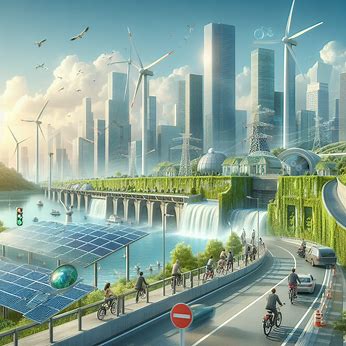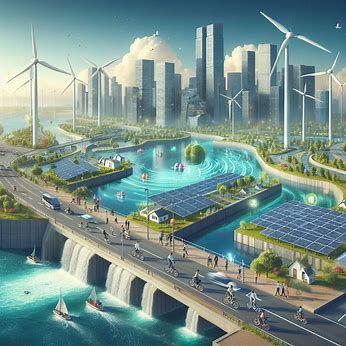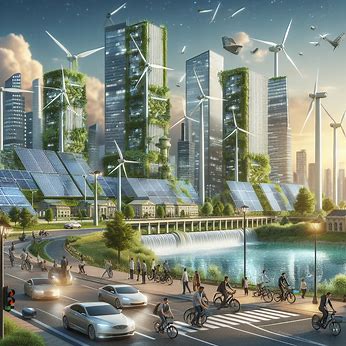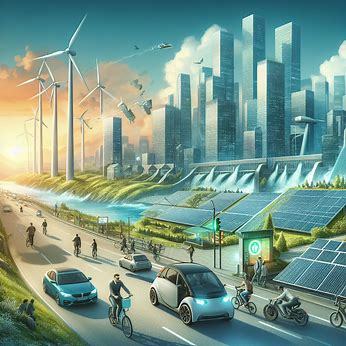The Power of Renewable Energy Technology
Renewable energy technology has surfaced as a lamp of stopgap in the fight against climate change and environmental declination. With the adding demand for clean and sustainable energy sources, renewable technologies similar as solar, wind, hydroelectric, geothermal, and biomass are gaining instigation worldwide. In this composition, we explore the different geography of renewable energy technologies, their benefits, challenges, recent advancements, and the vital part they play in shaping a sustainable future.
Understanding Renewable Energy Technology
Renewable energy technology harnesses natural coffers that are replenished constantly, furnishing a nonstop and environmentally friendly source of energy. Unlike fossil energies, which are finite and contribute to hothouse gas emigrations, renewable energy technologies use clean and abundant coffers similar as sun, wind, water, heat from the Earth's core, and organic matter.
1. Solar Energy Solar energy technology captures sun using photovoltaic( PV) cells or solar thermal systems to induce electricity or heat water for domestic, marketable, and artificial operations. PV cells convert sun directly into electricity, while solar thermal systems use glasses or lenses to concentrate sun and induce heat for brume turbines.
2. Wind Energy Wind energy technology harnesses the kinetic energy of wind to induce electricity using wind turbines. Wind turbines correspond of blades mounted on a rotor connected to a creator, which converts the rotational energy of the blades into electricity. Wind granges, located on land or offshore, harness the power of wind to produce clean and renewable electricity.
3. Hydroelectric Energy Hydroelectric energy technology utilizes the gravitational force of flowing or falling water to induce electricity. Hydroelectric power shops correspond of heads, budgets, and turbines that capture the energy of flowing water and convert it into electricity. Hydropower is one of the oldest and most extensively used renewable energy sources, furnishing a dependable and flexible source of electricity.
4. Geothermal Energy Geothermal energy technology gates into the heat stored beneath the Earth's face to induce electricity or heat structures directly. Geothermal power shops use brume or hot water from underground budgets to drive turbines and induce electricity. Geothermal heat pumps excerpt heat from the ground to give heating, cooling, and hot water for domestic and marketable structures.
5. Biomass Energy Biomass energy technology utilizes organic matter, similar as wood, crop remainders, and external solid waste, to induce heat, electricity, or biofuels. Biomass can be burned directly for heat or converted into biogas, biofuels, or biochar through processes similar as anaerobic digestion, turmoil, and pyrolysis.
Operations and Benefits of Renewable Energy Technology
Renewable energy technologies offer multitudinous benefits across colorful operations, including electricity generation, heating, cooling, transportation, and artificial processes. Some of the crucial benefits of renewable energy technology include
1. Environmental Sustainability Renewable energy technologies produce minimum hothouse gas emigrations and pollution compared to fossil energies, helping to alleviate climate change, reduce air and water pollution, and save natural ecosystems.
2. Energy Independence Renewable energy sources are abundant and locally available, reducing dependence on imported reactionary energies and enhancing energy security for countries and regions.
3. Economic Development Renewable energy technologies produce jobs, stimulate profitable growth, and attract investment in renewable energy structure, manufacturing, and exploration and development.
4. Cost Competitiveness The cost of renewable energy technologies, particularly solar and wind power, has declined significantly in recent times, making renewable energy decreasingly competitive with fossil energies in terms of cost per kilowatt- hour.
5. Energy Access Renewable energy technologies give access to electricity and ultramodern energy services for remote and underserved communities, perfecting quality of life, health, and education issues.
Challenges and walls
Despite their multitudinous benefits, renewable energy technologies face several challenges and walls to relinquishment, including
1. Intermittency and Variability Renewable energy sources similar as solar and wind power are intermittent and variable, depending on rainfall conditions and time of day, which can pose challenges for grid integration and energy storehouse.
2. Grid Integration Integrating large- scale renewable energy sources into being electricity grids requires upgrades to structure, grid balancing, and energy storehouse results to maintain trustability and stability.
3. Land Use and Environmental Impacts Large- scale deployment of renewable energy structure, similar as solar granges and wind turbines, may bear significant land use and can have environmental impacts on wildlife territories, ecosystems, and geographies.
4. Technological Limitations Some renewable energy technologies, similar as geothermal and biomass energy, are constrained by geographic position, resource vacuity, and technological limitations, limiting their wide deployment.
5. Policy and Regulatory walls Inconsistent programs, nonsupervisory fabrics, and fiscal impulses can produce walls to investment and deployment of renewable energy technologies, decelerating down the transition to a low- carbon energy system.
Advancements in Solar Technology improvements in photovoltaic accoutrements , thin- film solar cells, and concentrated solar power systems have increased the effectiveness and affordability of solar energy, making it a feasible option for large- scale electricity generation.
Wind Turbine inventions Advances in wind turbine design, blade accoutrements , and coastal wind technology have led to larger, more effective turbines able of landing further energy from the wind and operating in deeper waters, opening up new openings for coastal wind development.
Energy Storage results inventions in battery technology, pumped hydro storehouse, and thermal energy storehouse are perfecting the trustability and inflexibility of renewable energy systems, enabling grid integration, demand response, and cargo operation.
Smart Grid Technologies Smart grid technologies, similar as advanced metering structure, grid robotization, and demand- side operation, are enhancing the adaptability and effectiveness of electricity grids, enabling lesser integration of renewable energy sources and distributed energy coffers.
Policy Support and request Mechanisms adding commitments to renewable energy targets, carbon pricing mechanisms, and subventions for renewable energy deployment are driving investment in renewable energy structure and accelerating the transition to a low- carbon energy system.
Conclusion
Renewable energy technology holds immense pledge for addressing global energy challenges, mollifying climate change, and promoting sustainable development. By employing the abundant and clean energy coffers available to us, renewable energy technologies offer a pathway to a more flexible, indifferent, and prosperous future for generations to come. As we continue to advance renewable energy technology through invention, collaboration, and policy support, it's essential to prioritize sustainability, affordability, and inclusivity to insure a just transition to a renewable energy future.
RELATED POST....
radiation Protection technology
transportation technology on mars
Impact of Technology on Ancient Industries
the Environmental impact of E west
augmente reality in feild passage
nassa mission to touch the sun
important Rocket Set to Soar into the Cosmos
20 Instances of Digital Technology
wolrd fastest wooden satellite in 2024
Electric vehicles charging in 2024
Ultraloq Bolt and the Smart Lock
Unraveling the Apple Patent Dispute:
CineBeam Qube 4K UHD Projector
Twitter-X Elon Musk Content Moderation
tesla Cybertruck crash in palo alto








.jpeg)






.png)
0 Comments